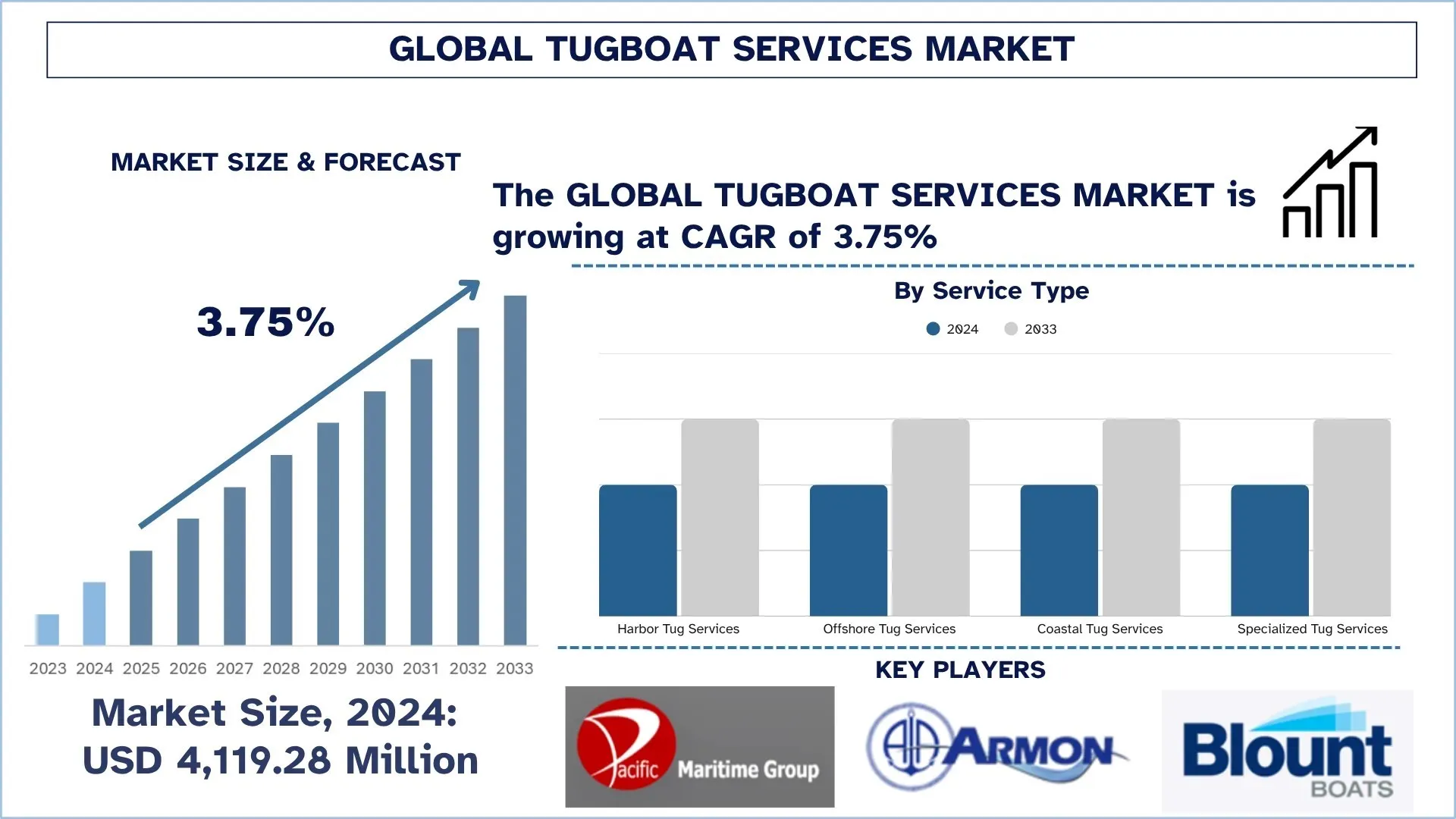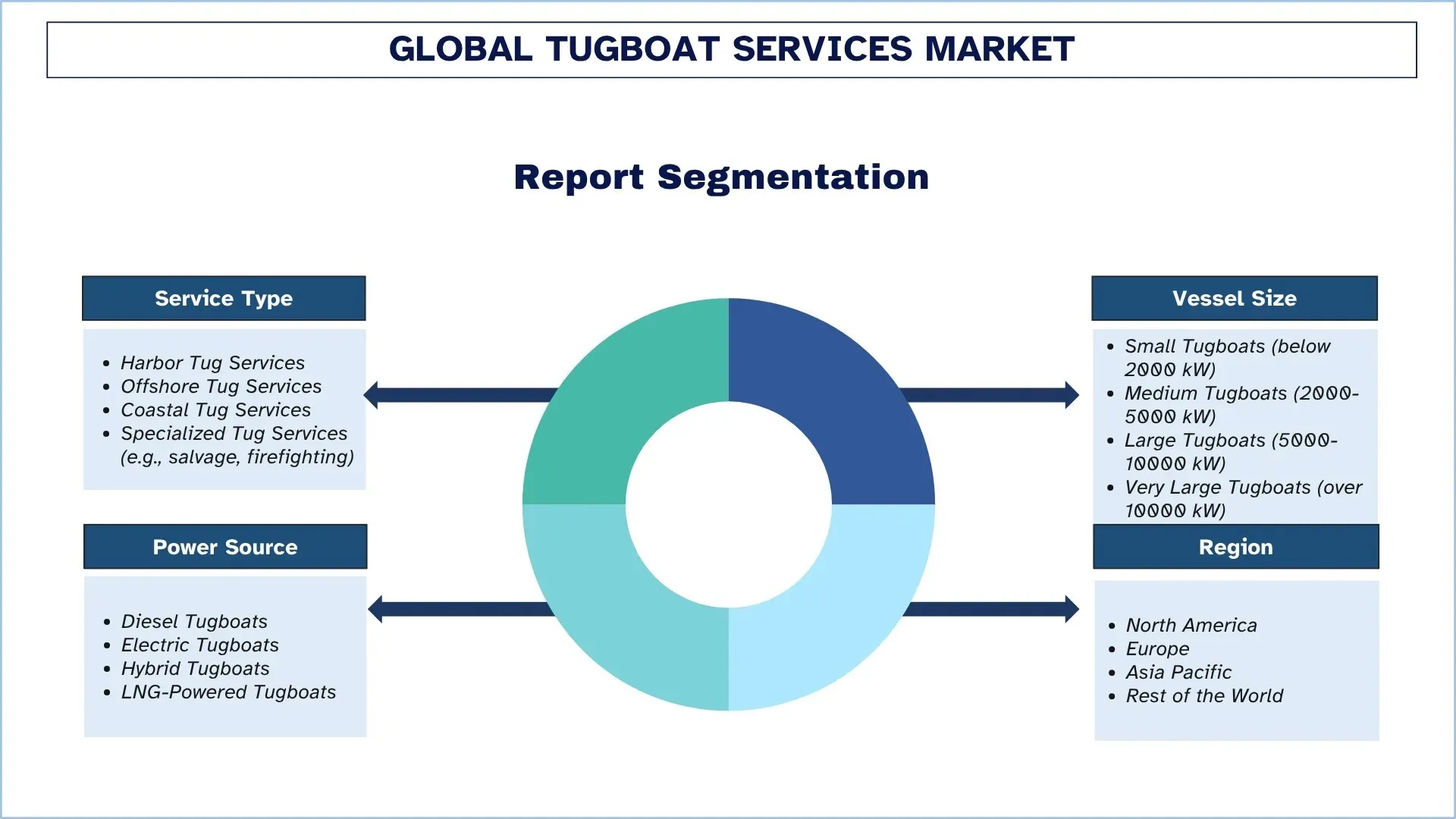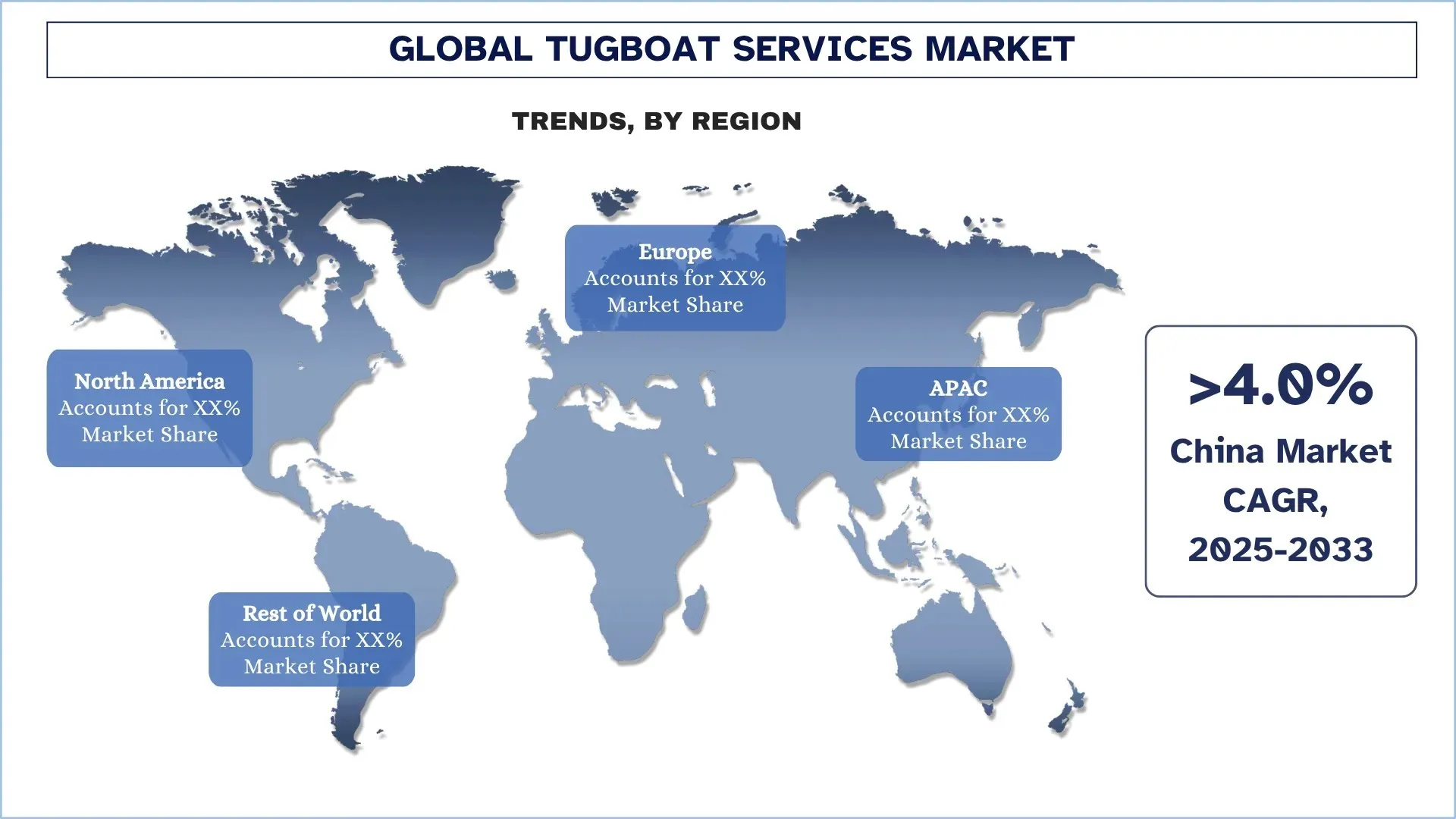- Home
- About Us
- Industry
- Services
- Reading
- Contact Us
Tugboat Services Market: Current Analysis and Forecast (2025-2033)
Emphasis on Service Type (Harbor Tug Services, Offshore Tug Services, Coastal Tug Services, and Specialized Tug Services (e.g., salvage, firefighting)); Vessel Size (Small Tugboats (below 2000 kW), Medium Tugboats (2000-5000 kW), Large Tugboats (5000-10000 kW), and Very Large Tugboats (over 10000 kW)); Power Source (Diesel Tugboats, Electric Tugboats, Hybrid Tugboats, and LNG-Powered Tugboats); and Region/Country

Global Tugboat Services Market Size & Forecast
The Global Tugboat Services Market was valued at USD 4,119.28 million in 2024 and is expected to grow at a CAGR of around 3.75% during the forecast period (2025–2033F), driven by growth in maritime trade and port operations, as well as investment in port infrastructure and new terminal developments.
Tugboat Services Market Analysis
The global tugboat services market is expected to grow steadily over the forecast period, driven by the ongoing rise in international maritime trade and the development of commercial ports. Tugboats are important for maneuvering, docking, undocking, towing, and escorting vessels in congested waterways and harbors. With the constant increase in the size of global ships, especially with the development of large LNG carriers, container ships, and mega tankers, the service of highly powerful, technologically advanced tugboats has become a necessity to ensure the efficient functioning of ports and reduce the risk of maritime accidents. The current market is proving quite dynamic, with ports and marine operators actively complying with stringent regulatory requirements and introducing sustainability-oriented operational frameworks. Moreover, the increasing number of offshore energy projects, such as oil and gas platforms and offshore wind farms, is also adding pressure on tug services' needs, especially in deep-water operations, which require multifaceted, robust towing and support services. The move toward environmental responsibility in the global maritime industry is also driving fleet modernization, as operators focus on low-emission vessels to meet new global standards for environmental management at sea. As the port development, offshore infrastructure, fleet modernization, and combined marine logistics continue their expansion, the market of tugboat services will have a consistent growth in the key maritime centers of the world, covering both the coastal and deepwater operations, as the need for safe, efficient, and sustainable vessel assistance increases.
Global Tugboat Services Market Trends
This section discusses the key market trends that are influencing the various segments of the global tugboat services market, as found by our team of research experts.
Electrification, Hybrid Propulsion, and the Adoption of Greener Tugboats
The global tugboat services sector is shifting towards the use of electrification, hybrid power, and more green models of the tugboats in a bid to conform to the tougher emission requirements, save on fuel prices, and ensure they make operations more efficient. There is increased pressure on ports and shipping operators to decarbonize harbor and escort operations, and investment in battery-electric, LNG-powered, and hybrid tugs is being sought. As an example, in June 2024, eWolf, the first all-electric ship-assist tugboat in America, was commissioned at the Port of San Diego, which provides zero emissions and high bollard-pull capability. This transition will help in providing cleaner air to communities near ports and make the providers of tug services the leaders in sustainable maritime support. Furthermore, owners of ageing ships are retrofitting them with battery or hybrid drives and installing shore-power systems to reduce harbor idling emissions, which will further encourage the take-up of more environmentally friendly tug services in other countries around the world.
Tugboat Services Industry Segmentation
This section provides an analysis of the key trends in each segment of the global tugboat services market report, along with forecasts at the global, regional, and country levels for 2025-2033.
The Harbor Tug Services Segment Dominates the Tugboat Services Market
Based on service type, the tugboat services market is segmented into harbor tug services, offshore tug services, coastal tug services, and specialized tug services. In 2024, the harbor tug services segment dominated the market and is expected to maintain its lead during the forecast period. This is largely because global seaborne trade has continued to grow, the development of more port infrastructure projects, and the ever-increasing influx of large-sized vessels in need of strong maneuvering support. The high demand for harbor tug operations is also endorsed by stringent regulations that govern the safety of the port and the need to reduce delays during operational processes. Moreover, more modernization efforts in the fleet through the introduction of sophisticated propulsion systems, low-emission technologies, etc., are enhancing the performance of harbor tug services in terms of efficiency, agility, and ecology, reinforcing the expansion prospects of the segment in major shipping centers of the globe.
The Medium Tugboats Market held the Largest Market Share in the Tugboat Services Market.
Based on vessel size, the tugboat services market is segmented into small tugboats, medium tugboats, large tugboats, and very large tugboats. In 2024, the medium tugboats segment held the largest market share and is projected to maintain its dominance throughout the forecast period. The increased use of these vessels during the day-to-day harbor services, coastal towing, and escorting services is what is primarily contributing to this increase and, as such, makes these vessels the most versatile and most cost-effective in terms of cost to the port authorities and marine operators alike. The growing international port traffic, as well as such operational requirements as tugs required to operate medium and larger commercial ships, also provides enhanced justification for the high demand in this segment. Moreover, improvements in hybrid and fuel-efficient propulsion ensure opportunities to improve performance, safety, and sustainability in medium-sized fleets, solidly supporting their future use throughout significant maritime areas.

Asia Pacific Dominated the Global Tugboat Services Market
Asia Pacific is the largest market for tugboat services and is expected to maintain its lead during the forecast period. The reason behind this domination is the high level of maritime trade in the region, the high capacity of ports, and the continual growth in port infrastructures of countries like China, India, Japan, and South Korea. The existence of large shipbuilding centers and the necessity to use powerful tug services to move larger vessels are only additional evidence proving the leading position of the region. The area is home to most of the busiest ports in the world, such as those in China, India, Japan, and Southeast Asia, which process large container, bulk, and energy-cargo volumes. Moreover, the frequent arrival and maneuver of ultra-large ships in these ports provides a high demand for tug services, particularly advanced harbor tugs, escort tugs, and coastal operations tugs. The growth of the marine sector is driving services in the towage and support vessels category through massive investments in port expansion, dredging, and the construction of deep-water berths and related marine infrastructure by governments and marine authorities in the region. Moreover, the area is expanded in offshore energy (e.g., LNG, offshore oil and gas platforms, offshore wind) and coastal shipping, which expands the demand beyond the conventional harbor operations to specialized and marine support tug business.
China held a dominant Share of the Asia Pacific Tugboat Services Market in 2024
The market of China tugboat services has a high potential and sufficient growth possibilities because of a fast-growing port network and the trade volumes of the country, dominated by maritime transport. Strict governmental standards of national emissions and the safety of vessel maneuver also stimulate the demand for complex services of tugs. The efficiency and environmental performance of older fleets of tugboats are improved by modernization and large-scale investment in electric and hybrid tugboats made by major Chinese ports. This has been accompanied by increasing offshore initiatives, including deepwater oil and gas field platforms and offshore wind farms, which are driving the demand by the operators to use multi-capability tugs and integrated towage services, making China a prime growth center in the tug market.

Tugboat Services Industry Competitive Landscape
The global tugboat services market is competitive, with several global and international market players. The key players are adopting different growth strategies to enhance their market presence, such as partnerships, agreements, collaborations, new product launches, geographical expansions, and mergers and acquisitions.
Top Tugboat Services Companies
Some of the major players in the market are Pacific Maritime Group, Astilleros Armon, Blount Boats, NAIKAI TUG BOAT SERVICE CO., LTD., GAC Group, Fremont Tugboat Company, Carver Companies, Norfolk Tug Company, Moran Towing Corps, and Crowley.
Recent Developments in the Tugboat Services Market
In November 2024, Damen Shipyards Group delivered six RSD Tugs 2513 to the Port of Antwerp-Bruges, including the first fully electric RSD-E Tug 2513 for zero-emission operations. The other five vessels feature Damen Marine NOx Reduction Systems, ensuring IMO Tier III compliance. This aligns with the port’s goal of carbon neutrality by 2050.
In October 2024, Sanmar Shipyards began construction on four electric tugs for BOTA? Petroleum Pipeline Corporation. This project strengthens sustainable towage operations in Türkiye, highlighting a shift toward eco-friendly maritime solutions.
Global Tugboat Services Market Report Coverage
Report Attribute | Details |
Base year | 2024 |
Forecast period | 2025-2033 |
Growth momentum | Accelerate at a CAGR of 3.75% |
Market size 2024 | USD 4,119.28 Million |
Regional analysis | North America, Europe, APAC, Rest of the World |
Major contributing region | Asia Pacific is expected to dominate the market during the forecast period. |
Key countries covered | U.S., Canada, Germany, U.K., Spain, Italy, France, China, Japan, and India |
Companies profiled | Pacific Maritime Group, Astilleros Armon, Blount Boats, NAIKAI TUG BOAT SERVICE CO., LTD., GAC Group, Fremont Tugboat Company, Carver Companies, Norfolk Tug Company, Moran Towing Corps, and Crowley |
Report Scope | Market Trends, Drivers, and Restraints; Revenue Estimation and Forecast; Segmentation Analysis; Demand and Supply Side Analysis; Competitive Landscape; Company Profiling |
Segments Covered | By Service Type; By Vessel Size; By Power Source; By Region/Country |
Reasons to Buy Tugboat Services Market Report:
The study includes market sizing and forecasting analysis confirmed by authenticated key industry experts.
The report briefly reviews overall industry performance at a glance.
The report covers an in-depth analysis of prominent industry peers, primarily focusing on key business financials, type portfolios, expansion strategies, and recent developments.
Detailed examination of drivers, restraints, key trends, and opportunities prevailing in the industry.
The study comprehensively covers the market across different segments.
Deep dive regional-level analysis of the industry.
Customization Options:
The global tugboat services market can further be customized as per the requirements or any other market segment. Besides this, UnivDatos understands that you may have your own business needs; hence, feel free to contact us to get a report that completely suits your requirements.
Table of Content
Research Methodology for the Global Tugboat Services Market Analysis (2023-2033)
We analyzed the historical market, estimated the current market, and forecasted the future market of the global tugboat services market to assess its application in major regions worldwide. We conducted exhaustive secondary research to gather historical market data and estimate the current market size. To validate these insights, we carefully reviewed numerous findings and assumptions. Additionally, we conducted in-depth primary interviews with industry experts across the tugboat services value chain. After validating market figures through these interviews, we used both top-down and bottom-up approaches to forecast the overall market size. We then employed market breakdown and data triangulation methods to estimate and analyze the market size of industry segments and sub-segments.
Market Engineering
We employed the data triangulation technique to finalize the overall market estimation and derive precise statistical numbers for each segment and sub-segment of the global tugboat services market. We split the data into several segments and sub-segments by analyzing various parameters and trends, including service type, vessel size, power source, and regions within the global tugboat services market.
The Main Objective of the Global Tugboat Services Market Study
The study identifies current and future trends in the global tugboat services market, providing strategic insights for investors. It highlights regional market attractiveness, enabling industry participants to tap into untapped markets and gain a first-mover advantage. Other quantitative goals of the studies include:
Market Size Analysis: Assess the current market size and forecast the market size of the global tugboat services market and its segments in terms of value (USD).
Tugboat Services Market Segmentation: Segments in the study include areas of service type, vessel size, power source, and regions.
Regulatory Framework & Value Chain Analysis: Examine the regulatory framework, value chain, customer behavior, and competitive landscape of the tugboat services industry.
Regional Analysis: Conduct a detailed regional analysis for key areas such as Asia Pacific, Europe, North America, and the Rest of the World.
Company Profiles & Growth Strategies: Company profiles of the tugboat services market and the growth strategies adopted by the market players to sustain the fast-growing market.
Frequently Asked Questions FAQs
Q1: What is the global tugboat services current market size and its growth potential?
The global tugboat services market was valued at USD 4,119.28 million in 2024 and is expected to grow at a CAGR of 3.75% during the forecast period (2025-2033).
Q2: Which segment has the largest share of the global tugboat services market by service type?
The harbor tug services segment dominated the market and is expected to maintain its lead during the forecast period. This is largely because global seaborne trade has continued to grow, the development of more port infrastructure projects, and the ever-increasing influx of large-sized vessels in need of strong maneuvering support.
Q3: What are the driving factors for the growth of the global tugboat services market?
• Growth in Maritime Trade and Port Operations: Rising global trade volumes and expanding port activities increase demand for tugboats to maneuver larger vessels, improve port throughput, and ensure safe, efficient berthing and docking operations.
• Investment in Port Infrastructure and New Terminal Developments: New terminals, deeper ports, and modernization projects require additional tugboat capacity and advanced vessels, driving service providers to scale operations and enhance fleet capabilities.
• Expansion into Offshore Support and Non-Traditional Applications: Tugboat services are diversifying into offshore wind farms, oil and gas support, salvage, and coastal defense roles, creating broader revenue streams and operational opportunities.
Q4: What are the emerging technologies and trends in the global tugboat services market?
• Electrification, Hybrid Propulsion, and Greener Tugboats: Operators are adopting hybrid and electric propulsion systems to cut emissions, reduce fuel costs, and improve sustainability in line with environmental goals and regulatory pressures.
• Digitalization, Automation, and Smart Operations: Advanced navigation, remote monitoring, and data-driven systems enhance safety, optimize fuel use, and improve service efficiency, leading to smarter tugboat operations and reduced downtime.
Q5: What are the key challenges in the global tugboat services market?
• Stringent Environmental and Emissions Regulations Increasing Costs and Complexity: Compliance with emissions standards, sustainability requirements, and fuel policies demands costly upgrades, cleaner technologies, and operational adjustments that pressure profit margins.
• High Capital and Operational Costs Combined with Ageing Fleets: Tugboat acquisition, maintenance, and crew costs are substantial; many fleets require replacement or modernization, making investment decisions difficult amid price-sensitive markets.
Q6: Which region dominates the global tugboat services market?
Asia Pacific is the largest market for tugboat services and is expected to maintain its lead during the forecast period. The reason for this domination is the region's high level of maritime trade, the capacity of ports, and the continual expansion of port infrastructure in countries like China, India, Japan, and South Korea. The existence of large shipbuilding centers and the need for powerful tug services to move larger vessels are only additional evidence of the region's leading position.
Q7: Who are the key players in the global tugboat services market?
Some of the key companies include:
• Pacific Maritime Group
• Astilleros Armon
• Blount Boats
• NAIKAI TUG BOAT SERVICE CO., LTD.
• GAC Group
• Fremont Tugboat Company
• Carver Companies
• Norfolk Tug Company
• Moran Towing Corps
• Crowley
Q8: What role do partnerships and collaborations play in the tugboat services market's growth?
• Strategic Alliances with Technology Providers: Collaborations with maritime tech companies accelerate the adoption of digital navigation, remote monitoring, and emissions-tracking systems, enhancing operational efficiency, safety, and regulatory compliance.
• Joint Ventures with Ports and Offshore Energy Firms: Partnerships with port authorities, oil & gas operators, and offshore wind developers support fleet expansion, specialized vessel deployment, and dedicated tug operations for new terminals and offshore projects.
• Public-Private Partnerships (PPPs): Government collaboration drives port modernization, deeper berths, and maritime infrastructure upgrades, increasing towing demand and enabling tug operators to secure long-term service contracts.
Q9: How is the global supply chain affecting the tugboat services market?
• Trade Route Diversification: Shifting shipping lanes due to geopolitical risks and new trade agreements increases tug service requirements across emerging ports, improving fleet utilization and market expansion.
• Increased Port Congestion Management Needs: Supply chain disruptions and fluctuating cargo volumes create operational bottlenecks, raising demand for tug assistance to improve vessel turnaround and maintain port productivity.
• Growth of Regional Manufacturing and Export Hubs: Expansion of industrial and energy production near coastal zones drives higher vessel traffic and a sustained need for tug support in loading, berthing, and escort operations.
Related Reports
Customers who bought this item also bought










